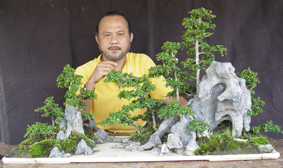What is Lingnan penjing? What are there in Lingnan penjing that are so different from other penjing schools? What is the “Grow and Clip” method? These are the topics Teacher Wong talked about in my first Lingnan penjing class two years ago, and now I would like to share with you part of the content in my Lingnan penjing 101 class (you can also find this in the official website of Institute of Lingnan Penjing, Hong Kong which I am busy working on now).
Spring from the Mother Nature, Exceed the Mother Nature
Chinese Lingnan penjing embraces the Mother Nature. While it imitates the fascinating scenery in the nature, it is not bounded by any rule or formula. Because of its ability to associate its audiences with the beauty and majesty of the Mother Nature in a merely small pot, Lingnan penjing is praised as an art that “Spring from the Mother Nature, Exceed the Mother Nature” (源於自然,超於自然).
Convey Messages and Thoughts through Comprised Style and Ambiance
Lingnan penjing is not only about the outer beauty. Every penjing has its own unique ambiance and mood. When viewing a Lingnan penjing, one should savor the messages and emotions that the Lingnan penjing artist is trying to express.
Prune Trees with “Grow and Clip” Method
Lingnan penjing artists prune trees with the “Grow and Clip” method. Instead of bending by wires, the branches are kept being clipped as they grow. Every clipping creates a new turn and a new session on the branch, and in every session, there grows new branches. Eventually, as the tree keeps growing and being pruned by this particular method, it will taper from the base to the apex, the proportions between the trunk and branches will be greatly developed, with branches full of turns and twists.
If you are interested in knowing more about the other schools of penjing, I would recommend you to check out this page in Phoenix Bonsai Society’s website which talks many different penjing schools in details.





















